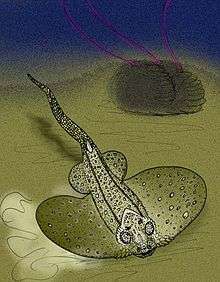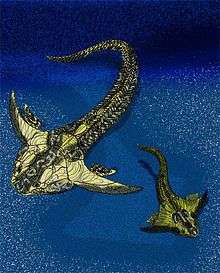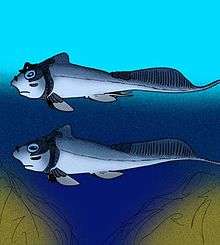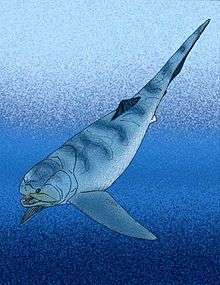Antiarchi
Antiarchi ("Opposite anus") is an order of heavily armored placoderms. The antiarchs form the second-most successful group of placoderms after the arthrodires in terms of numbers of species and range of environments. The order's name was coined by Edward Drinker Cope, who, when examining some fossils that he thought were armored tunicates related to Chelysoma, mistakenly thought that the orbital fenestra (i.e., the hole in the headshield for the eyes, nose and pineal foramen) was the opening for the mouth, or oral siphon, and that the opening for the anal siphon was on the other side of the body, as opposed to having both oral and anal siphons together at one end.
| Antiarchi | |
|---|---|
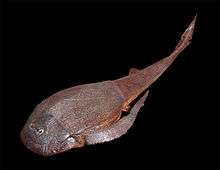 | |
| Bothriolepis canadensis | |
| Scientific classification | |
| Kingdom: | Animalia |
| Phylum: | Chordata |
| Class: | †Placodermi |
| Order: | †Antiarchi Cope, 1885 |
The front portions of their bodies were heavily armored, to the point of literally resembling a box with eyes, with the sometimes scaled, sometimes naked rear portions often becoming sinuous, particularly with later forms. The pair of pectoral fins were modified into a pair of caliper-like, or arthropod-like limbs. In primitive forms, such as Yunnanolepis, the limbs were thick and short, while in advanced forms, such as Bothriolepis, the limbs were long and had elbow-like joints. The function of the limbs are still not perfectly understood, but, most hypothesize that they helped their owners pull themselves across the substrate, as well as allow their owners to bury themselves into the substrate.
Phylogeny
Below is a cladogram from Jia et al. (2010):[3]
| Antiarchi |
| |||||||||||||||||||||||||||||||||||||||||||||||||||||||||||||||||||||||||||||||||||||||||||||||||||||||||||||||||||||||||||||||||||||||||||||
Timeline of genera

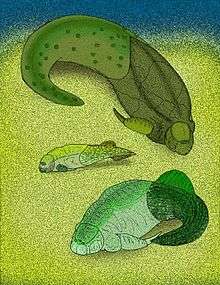
External links
References
- Burrow, Carol; Turner, Susan (September 1998). "A review of placoderm scales, and their significance in placoderm phylogeny". Journal of Vertebrate Paleontology. 19 (2): 204–219. doi:10.1080/02724634.1999.10011135.
- Wang Junqing (1991). "The Antiarchi From Early Silurian Hunan" (PDF). Vertebrata PalAsiatica. 21 (3): 240–244. Archived from the original (PDF) on 2013-12-12. Retrieved 2013-05-27.
- Jia, L. T.; Zhu, M.; Zhao, W. J. (2010). "A new antiarch fish from the Upper Devonian Zhongning Formation of Ningxia, China". Palaeoworld. 19 (1–2): 136. doi:10.1016/j.palwor.2010.02.002.
- Long, John A. The Rise of Fishes: 500 Million Years of Evolution Baltimore: The Johns Hopkins University Press, 1996. ISBN 0-8018-5438-5
- Sepkoski, Jack (2002). "A compendium of fossil marine animal genera (Placodermi entry)". Bulletins of American Paleontology. 364: 560. Archived from the original on 2004-10-14. Retrieved 2011-05-20.
